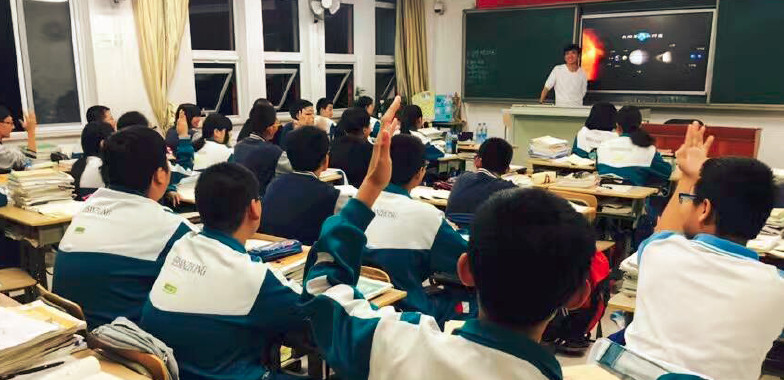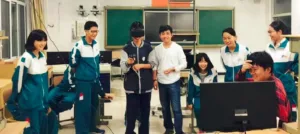Quick Search: Research is a series dedicated to unpacking some of the emerging research on 3D, VR, and other dynamic visualization technologies. See my introductory article for this series, entitled the Research Chase. In this article, I highlight some recent research emerging from China in the arena of VR in education.
A Case Study – The Impact of VR on Academic Performance, published jointly by the Beijing Bluefocus E-Commerce Co. and the Beijing iBokan Wisdom Mobile Internet Technology Training School, first came to my attention in early December. It offered some promising, although limited, insight into the use of VR in education.
Purpose
The experiment sought to show the difference between traditional teaching and VR-based teaching in astrophysics, along with impact upon student learning.

Assumptions
The authors explain that, in astrophysics, students cannot really “conduct experiments” like they would in other classes. “Students can only try to understand it through their imagination and teacher’s explanation,” they suggest. The study assumes that VR-based teaching is “vivid and interactive,” making it entirely possible for students to understand abstract concepts “in a three-dimensional way; conduct simulated operations; and let students experience the scenarios at different cosmic velocity.” Another assumption held was the notion VR in teaching would support both theoretical knowledge as well as practical skills training by providing an immersive learning experience, enhancing students’ sense of active involvement in class, and simply making learning more fun. The authors kvetched: “Most students lack interest in boring teaching and learning.” Enter virtual reality.
Procedures
The study was conducted at two full-time high schools in Beijing, with equal numbers of male and female students. They represented from A to C students in their normal classroom performance. The students were divided into groups for this study: one group adopted VR-based instruction (defined as thirty minutes of VR-based teaching), while the other group approached the content from a traditional teaching perspective (defined as thirty minutes of lecture and PowerPoint). The same teacher was employed in all groups to avoid any experiment deviation caused by the professional difference among teachers. Immediate post-tests were then administered after the teaching to contrast both the academic performance and learning efficiency between the two groups. A second test was administered two weeks later to see if new knowledge was retained. Note that three HTC Vive virtual reality headsets were used in this study.
Conclusions
The study provided both quantitative and qualitative findings. These are summarized below:
Quantitative Findings
- At first blush, the use of VR in teaching seems to have a positive effect on test scores: The average score of the VR group was 93%, while the traditional instruction group evidenced a 73% average. The lowest score of the VR group was 75%, while the lowest score in the first post-test for the traditional instruction group was 40%. In another measure, the VR group demonstrated a 27.4% growth in scores.
- The study also spent some time analyzing learning efficiency: only one student in the VR group required repeated teaching and follow-up testing to achieve mastery, which, accounted for 10% of the group members; in comparison, six students in traditional teaching group required reteaching, accounting for 60% of those students. According to the researchers, this suggests a certain level of spent-time learning efficiency that advantages schools with limited resources.
- The use of VR in learning also appeared to offer positive results for knowledge retention. In the second test, administered two weeks later, the average score of the VR group approached 90%, while that of the traditional teaching group settled in at 68%. According to the authors, this suggests that knowledge taught in a traditional fashion is more inclined to be forgotten quickly.
- The study also unearthed, according to the researchers, an unexpected discovery: “The average score of C students in the VR group reached 88%, 15.8% higher than that of the A students in the control (traditional) group.” The researchers concluded: “Every student has a special gift. As we found in the experiment, the right teaching method helps to discover children’s unlimited potential.” Incidentally, past U.S. technology studies harmonize with this discovery: many technologies have a greater impact on struggling students than they do on highly successful students.
Qualitative Findings
- As is common in other case studies I have examined, students in this study are enthusiastic about the use of virtual reality in science instruction. “The introduction of the latest VR technology into education is very fascinating to students, who are looking forward to seeing VR-based teaching integrated in their classes,” report the study’s authors. Notably, the female students were more likely to recommend VR instruction to others than the male students. That’s a pleasant surprise.
- Students and teachers were also polled about which content areas they would most like to see peppered with VR content. The chart below shows their preferences. (In the U.S. , I sense there would be higher interest in mathematics and social sciences.)
Overall, this study concludes on a high note: “Every child is a genius in his or her own way. VR can be the key to awakening the genius inside.” The authors conclude: “Students from each grade level achieved more progress by VR-based learning than traditional teaching.”
My Analysis
My own feelings about of this study are mixed. Here are some positive points to consider:
- The study’s focus on education is laudable. We need as much insight as we can get into using virtual reality for educational settings.
- The study tackles a perfect subject area—astrophysics—and asks the perfect question: “Will visualization (in this case VR) help students learn this difficult and abstract content?”
- The study is smart to focus on stubborn, recurring learning challenges. Using a promising technology to tackle an “easy” topic is simply unimportant.
- The study takes a closer look at the notion of measuring learning efficiency, which here is defined as reducing the amount of reteaching necessary to push students toward content mastery. More studies should look at this solid “return on investment” for teaching with VR.
Taking a more contrary point of view, I recognized a number of problems with this study:
- I am concerned any time I see for-profit sponsors/authors of a research project. (Both sponsors of this study are commercial interests.) Although the findings are helpful, it is clear to me that this study was designed to promote the expanded use of VR learning, not merely understand it. Little chunks of uncensored hyperbole spread throughout the study leave me with this awkward feeling.
- The study has an extremely low sample size, or low n, ensuring that the findings cannot really be as conclusive as suggested.
- The low sample size, along with the small number of HTC Vive units employed brings into question the scalability of implementing this technology in actual school settings, where student numbers are higher, and equipment costs would clearly skyrocket.
- The focus on retention is troubling. This is low-lying fruit in the minds of educators. We want deeper learning, critical thinking, analysis, and synthesis. Two-week retention tests also seem contrived. Why not a month or two months?
- The type of testing that was administered remains unstated. What kind was it? Multiple choice testing? Essay writing? Performance testing? Previous research in this field suggests that students using visualization technologies perform better on essay-type tests (requiring higher-order thinking) than they do on multiple choice tests (requiring factual regurgitation).
- The refrain throughout the study is that VR works well in education and produces positive academic results because it is FUN. Is that notion the best this research can offer as an explanation for the value of this technology? I think not. Game research suggests that challenge, competition, and noble failure are more motivating to us than fun; recent neuroscience or brain research might point to curiosity, storytelling (narrative), relevance, vividness, and novelty as the primary motivators working in and through VR technology. Fun is a byproduct.
Still, this ‘light’ research is not unimportant. As I wrote in the introductory article to this series: “For me, all types of research matter… I prefer to read and report on all of it. Each study, survey, action research effort, or anecdotal collection provides us with the clues, contacts, and stepping stones to learn more. Each enables us to grow wiser, gather fresh insight, and seize upon new perspective.” So there you have it. As I pondered this research study, I remembered the Hindi proverb: “Even a drowning man catches a straw.” Yes, the results of this study are all “good to know.” They advance our knowledge another step or two forward. –Len Scrogan

